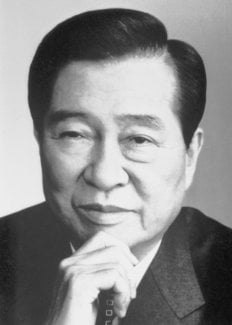Kim Dae-jung
Biographical

President Kim Dae-jung was born on 8 January 1924* in a small village on an island of South Korea’s southwestern coast. He graduated from a commercial high school in 1943.
When the Syngman Rhee Administration (1948-1960) began to become increasingly dictatorial, he decided to enter politics. His political career proved to be rather turbulent from the start. He was elected to the National Assembly in a bi-election in 1961 after two unsuccessful bids, but, within three days of his election, the National Assembly was dissolved following a military coup d’etat led by Major General Park Chung Hee.
When he was elected again to the National Assembly in 1963, he began to emerge as a junior leader within his own party. He served as the spokesman for the Democratic Party in 1965 and became the chairman of the party’s Policy Planning Committee the following year.
As President Park Chung Hee sought constitutional revisions in 1969 to allow himself to run for a third term, Kim Dae-jung gave an address against the scheme in an outdoor rally, and he was widely acclaimed for his vision and courage. He was chosen the presidential candidate of the New Democratic Party in 1971, running against the all-powerful incumbent, Park Chung Hee. Despite the obstructionist tactics and illegal electioneering practices of the ruling party, he garnered over 46 per cent of the votes cast.
During the Assembly election campaign that soon followed the presidential vote, opposition leader Kim experienced what was to be the first of at least five attempts on his life by his political foes. A heavy-load truck rammed into his car, seriously injuring him and his two aides. President Kim still suffers from the leg injury.
Barely a year after the election, President Park imposed martial law, banned all political activities and rammed the so-called Yushin (revitalizing reform) Constitution through the National Assembly. It gave the president power for life. Kim Dae-jung strenuously objected to these extra-legal measures and led campaigns against Park’s regime in the U.S. and Japan. In August 1973, agents of the Korean Central Intelligence Agency abducted Kim from a Tokyo hotel. The plot was to “eliminate” him but swift and strong reactions from the U.S. and Japan resulted in his release in Seoul a week later. He was immediately placed under house arrest.
On March 1, 1976, the indomitable opposition leader joined other democracy fighters in issuing the “Independence Day Declaration for Democratization,” which touched off yet another wave of pro-democracy demonstrations in Korea. Subsequently, he was sentenced to five years in prison. He remained in jail until the authorities released him and put him under house arrest in 1978.
Soon after President Park was assassinated by one of his close aides in October 1979, Kim had his civil and political rights restored. After a few months of political unrest another group of soldiers seized power and Kim Dae-jung was thrown into prison, again, in May 1980 on charges of treason. In November of that year, a military court sentenced him to death. The sentence was later commuted to life imprisonment, and then to a 20-year term. In December 1982, his prison term was suspended, and he was allowed to travel to the United States.
Kim ended his exile in the U.S. and returned home in early 1985 despite his supporters’ warnings that he might meet the same tragic fate as Philippine Senator Benigno Aquino. Back in Seoul, he was immediately put under house arrest but his return intensified the nationwide pro-democracy movement. In June 1987, Kim was cleared of all outstanding charges and his civil and political rights were fully restored. He ran and was defeated in presidential elections in 1987 and 1992.
In December 1997, he was elected to the presidency, winning 40.3 per cent of the votes. When he was inaugurated as the eighth President of the Republic of Korea, it marked the first transition of power from the ruling to the opposition party in Korea’s modern history.
Taking over the government in the midst of an unprecedented financial crisis, President Kim devoted himself to the task of economic recovery and managed to pull the country back from the brink of bankruptcy. Reforms and restructuring that began early in his Administration still continue.
President Kim Dae-jung’s vision for the Korean people led him to pursue a policy of engagement toward North Korea. He and North Korean leader Kim Jong-il worked together on a joint declaration they signed on June 15, 2000 paving the way for a brighter future for all Koreans and other peace-loving peoples of the world.
This autobiography/biography was written at the time of the award and later published in the book series Les Prix Nobel/ Nobel Lectures/The Nobel Prizes. The information is sometimes updated with an addendum submitted by the Laureate.
* There has been uncertainty around the birthdate of Kim Dae-jung, but his actual Gregorian calendar birth date is 8 January 1924. See Kim Dae-Jung Presidential Library and Museum of Yonsei University
Kim Dae-jung died on 18 August 2009.
Nobel Prizes and laureates
Six prizes were awarded for achievements that have conferred the greatest benefit to humankind. The 14 laureates' work and discoveries range from quantum tunnelling to promoting democratic rights.
See them all presented here.
